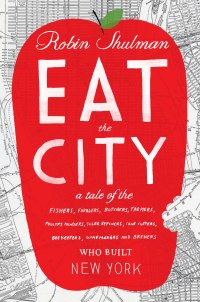
Robin Shulman. (Photo by Beowulf Sheehan.)
The title of Robin Shulman’s book says it all. Eat the City: A Tale of the Fishers, Foragers, Butchers, Farmers, Poultry Minders, Sugar Refiners, Cane Cutters, Beekeepers, Winemakers, and Brewers Who Built New York weaves together historical perspective on food production with a romp through the Big Apple’s modern-day food landscape. In it, Shulman writes:
When I began to work on this book, I thought I would be spending time with people who had been shunted to the edges of an overdeveloped city. But over time, meeting people and reading history, I started to realize that people who produce food draw others around them; they are not isolated, but among the most connected. As much as any other group of laborers and artists, they are the culture of New York. They are the ones who wrangle space to manufacture foods and share them at feasts and ceremonies — the things that help weave the unruly, disparate strands of the city into something uniquely itself.
I spoke with Shulman recently about her motivation for writing Eat the City, as well as “hipstervores,” red beehives, and New York’s dark role in the sugar trade. Below is an excerpt from our conversation.
Q. In the Eat the City acknowledgements you recognize the inspiration of writers who have shown you that “Writing ostensibly about food can be … powerful enough to tell the story of everything else.” Does that describe on your approach to writing it?
A. Eating is at the core of our lives. Everyone has to eat and food has to be a part of the way our economy functions. It’s a part of our culture and our memories. It’s part of where we come from and where we want to be. So by telling the story of the food, I could talk about people’s life histories and what they care about most.
Q. And you also really tell the story of a city.
A. Yes, it turns out that food is really core to the way cities have been constructed and the way that they function today.
 Q. Eat the City also confirms that the popular interest in where food comes from and how to make it is not a passing trend, but a sort of return. I came away from it believing that the last 50-year period — wherein we’ve been somewhat disconnected from food — has been the oddity.
Q. Eat the City also confirms that the popular interest in where food comes from and how to make it is not a passing trend, but a sort of return. I came away from it believing that the last 50-year period — wherein we’ve been somewhat disconnected from food — has been the oddity.
A. Exactly, that’s the aberration. But even as mainstream culture has been disconnected from food, and most people have been getting most of their food from big grocery stores — even then there were all kinds of people continuing on with older means of food production. So it’s not that it has ever been gone.
Q. The Harlem-based urban farmer whose story you tell — Willie Morgan — seems to be a really good example.
A. I love his story. Willie was running this numbers joint and he wanted to have a cover for the cops and also reward his customers by giving them free food. But there’s also something much deeper in that he came from this generation of African Americans who migrated from the South and brought with them all these food traditions and all this knowledge that one way or another they figured out how to use in the city. And at a point in the city when all of a sudden there was a lot of land.
Q. Right. You write about the rampant fires in Harlem in the 1960s that cleared a lot of space for farming. It doesn’t seem likely that we’ll see a lot of open space open up in New York in the foreseeable future. What can we learn from that period?
A. There are still cities in other parts of the country where it is happening. If you look at Detroit, there’s a lot of land available for farming. It has also happened in Buffalo, and other economically depressed cities recently. But even in New York and San Francisco, [land availability] has crested and fallen again in direct relation to the economy. It’s a pattern that has happened repeatedly since the late 1800s. Whenever there’s an economic fall, people use the space where other buildings were to produce food to feed those who are hungry. It could definitely happen again in cities like New York.
Q. How do you respond to smart-growth advocates who say that growing food shouldn’t be a priority in cities when compared to building denser housing and office space?
A. I think people need to feel that they can have human-scale development and a real impact on the world around them. Urban farming provides that and also brings us together in a way that almost nothing else can. People who are invested in producing something valuable to them — like food — will continue to spend time in a place over time, over seasons, over years and form relationships with each other that are hard to quantify. It can really change the fabric of a neighborhood. For example, there was an article in Mother Jones about how urban farms in Philadelphia were found to actually reduce crime over time.
Q. You use the phrase “hipstervore” to describe a certain brand of food producer and eater in New York. That’s great, but how do we expand beyond hipstervores?
A. The hipstervores are enthusiastic; they spread the message. And what’s important to recognize is that they’re just one constituency among many. I’ve talked to all kinds of other people who are coming new to the idea of urban agriculture or other kinds of food production in cities. I’ve talked to people in really low-income neighborhoods who are struggling to get by and who really want to produce better food for their kids than what they can afford or find in grocery stores. Then there are immigrants who are producing food like they did in other places. There are also elderly people who have been making food their whole lives. So I think it’s important to recognize that hipstervores are simply the most visible group. In every neighborhood in New York City, there are people who care about this issue.
Q. What was the most compelling information you unearthed while researching New York’s food past?
A. One chapter I loved researching was the story of sugar production in N.Y.C. I had no idea that sugar processing really made New York into the global world-class city that it is today. But most of the money came from the sugar plantations in the Caribbean, where the sugar itself was grown by African slaves. So it was a dark and horrible industry I had never heard of before.
The history of what happened to farming in New York was also really fascinating. As late as the 1880s, Brooklyn and Queens were the two biggest vegetable-producing counties in the entire country. And even into the 1940s there were still farms in upper Manhattan and they were feeding the surrounding apartments, with vegetables, eggs, and milk.
It was astonishing to read about the city in its various incarnations. I thought I would find a really linear history, where there was agriculture and then it was gone. But that’s not what happened. There was agriculture and then it changed and the kinds of agriculture shifted and the locations changed, but it never fully left.
Q. You touch on honey, meat, vegetables, sugar, fish, wine, and beer. Did you have a favorite chapter to write?
A. The honey chapter was one of my favorites. It showed me a city I didn’t know was there, when I started to see it from a bee’s perspective. I started to see all the flora available; there are flowers growing in traffic islands, on fire escapes, on street trees that bloom all summer long. These are things you pass by all the time, but you don’t really think about the city as a living thing that can be so productive with so little human attention.
Q. The story of the bees that gathered juice from a maraschino cherry factory and turned their hives red is one of the most interesting examples of the ways nature and industry collide in cities.
A. A lot of people have brought up questions about whether or not we should be producing honey — and food in general — in cities because there are so many pollutants nearby. Well, I talked to dozens of rural beekeepers trying to find out whether this type of thing has happened before, and they have the exact same kinds of problems. Rural beekeepers described bees bringing back sawdust from lumber factories or sugar from sugar refineries, etc. And then the obvious problem with honeybees in rural areas is pesticides, and the whole problem of Colony Collapse Disorder, which is linked to pesticides. And that is not as much of an issue in cities.
We have this bucolic image of rural life and we think that whatever food comes from the country is safe, but in fact the way that our rural landscape has developed in this country — it’s full of chemicals and toxins. It kind of challenges the assumptions about what city life means. Is it really that dirty and contaminated? And what rural life means; is it really that pure and clean?




